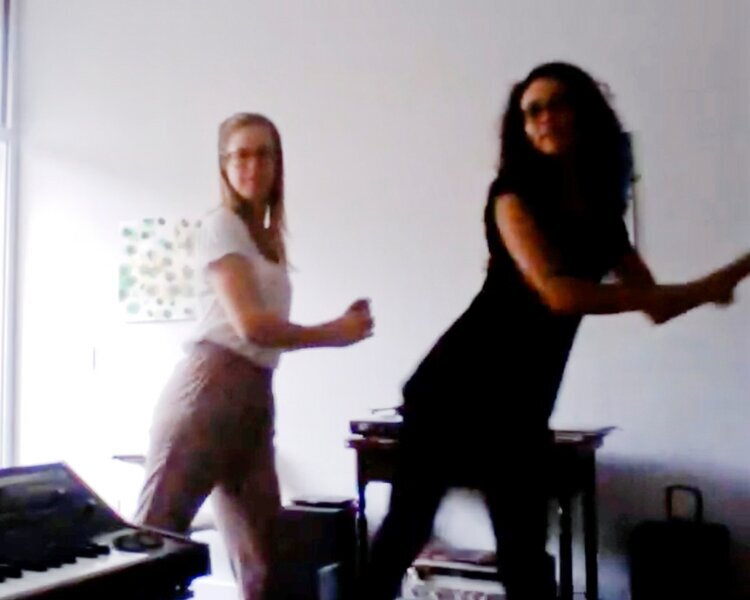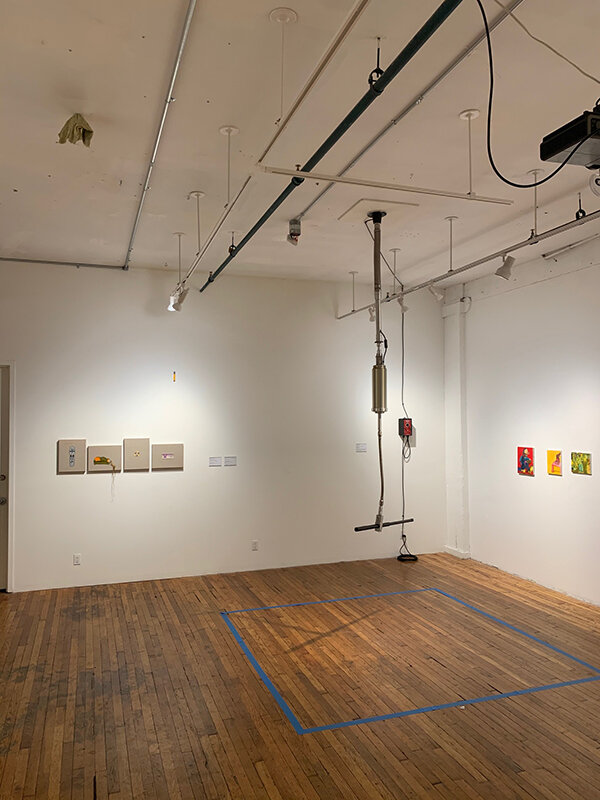BEASTS LIKE ME
Thu, Oct 22 - Sat, Nov 21, 2020
How to Dance
On view through October 16, 2020
Curated by Phyllis Rosenzweig
ARTISTS
Lindsay Benedict/ Julia Brown/ Mark Bradford/ Klara Liden/ Glendalys Medina
How to Dance explores dance as a fun, awkward, imperfect, joyful way of moving, whether it is completely spontaneous, the culmination of disciplined practice, or some combination of the two.
In Finnish Dance Instruction the artists Lindsay Benedict and Julia Brown record themselves trying to learn steps to a dance from instructions given in Finnish, a language neither of them understands. Both artists, who have long been interested in exploring cultural boundaries and in what we can learn about ourselves through movement, here share a moment of whacky informality and unself-conscious fun as they rise to the challenge of their self-imposed task.
Memorias en Arte- Artist Zoom Talks
Thursday June 4th, 2020 at 4pm with Daryl Myntia Daniels, Andre Treiner and Michael Obele
Thursday June 4th, 2020 at 6pm with BG 183 and Olga Correa
Friday June 5th, 2020 at 6pm with Gavy, The Bronxer and Gloria Zapata
Saturday June 6th, 2020 at 6pm with Anjl and Jadie
Memorias en Arte
May 18,- June 13, 2020
Curated by Gloria Zapata
ARTISTS
Olga Correa / Coco144/ Aida Miro / Lady Jday / Shiro / Gavy / Anjl / Crisselle / Jadie Meprivert / Daryl Myntia Daniels / Gloria Zapata / BG 183 Tatscru / Nicer Tatscru / Chris RWK / Yes0ne / Zimad / The Bronxer / Andre Trenier / Jonathan De Los Santos / Michael Obele
This series is an exploration of Gloria Zapata’s roots and culture. Como una mezcla, Zapata’s traditional upbringing meets the diaspora of NYC. As a Bronx based artist, she contends with the idea of memories and images from her childhood and how they can invoke an emotive response in others. From scenic landscapes to portraits and architecture, Zapata captures the essence of her home in Honduras. As she invites NYC artists to offer their own rendition of her photography, this collaboration explores their different interpretations of home. Zapata hopes that this exhibit may prompt viewers to not just ponder on the heritage that has molded a people but also asks you to remember and celebrate de donde vinimos.
Memorias En Arte curated by Ella Santos
Monday, May 18, 2020
Labor
Curated by Camilo Alvarez
ARTISTS
Vito Acconci
Melissa Calderón
Cheyenne Julien
Adeline Lulo
Arnaldo Morales
Fred Wilson
The exhibition will treat the art-work as a figure head for labor.
The curator briefly worked for Vito Acconci's studio. His concerns were closely connected to the class divisions and distinctions he experienced as an artist coming from uptown trying to work downtown. Supplying and providing food is at the heart of labor, we do it all for food. Preparing and getting food is highly unpaid labor. Acconci's plans for the Food Screw saves the family time in food preparation.
Melissa Calderón's embroideries of objects harken to the factory jobs many an immigrant family toiled in. The artists' grandmother was a seamstress . She sows images of objects that surrounded her life in unemployment; the quotidian remote control used for hours of entertainment and procrastination.
Cheyenne Julien's selected paintings caricaturize the daily concern of work and getting there as in Better Late than Never and Moneybag. Adeline Lulo's photographic series, Si Dios Quiere, translates to 'God Willing', refers to the unknown destiny of life. If God wants me to succeed or survive it is His will. Its inferred that only God has the ability to provide. In the meantime, I will abide by family, friends and farm animals for toil, haircuts and entertainment.
Arnaldo Morales' Bronx machine shop is an art work unto itself wherein he resuscitates the history of machines to make new objects that contribute to culture. The policeman's nightstick is a symbol of oppression be it for those working the street or laborers fighting for better working conditions. Throughout his career, Fred Wilson has challenged assumptions about race and museum display by masterfully juxtaposing and reframing artworks in opposition to simple objects. His work melds cultural symbols and unconventional materials, raising questions about erasure and exclusion in society.
Open Studio Genesis Jerez-BAS artist in residence
Saturday, February 22, 2020
Realism, Reality and Surreality
January 24th - February 29th, 2020
Curated by Sabine Schumacher
ARTISTS
John Ahearn
Carla Rae Johnson
Jun-Cheng Liu
Devon Rodriguez
Sarah Sagarin
From metaphoric trompel’oeill to sardonic commentary and Surreality five artists on view at BronxArtSpace grapple with differing dimensions of reality, transformed and altered reality. John Ahearn and Devon Rodriguez exhibit their artistic dialogue with images of each other. Carla Rae Johnson’s Séance Series pairs remarkably different individuals converging across time, space, and culture. Jun-Cheng Liu ‘lifts some of the ancient Chinese characters off their dusty pages into the 3rd Dimension”. Sarah Sagarin follows the path of the Surrealists by starting every new painting with no road map, no source material, and steers clear of any conscious intent or preliminary subject.
Sandra Araújo Mom, I’m Not Eating still image from video






